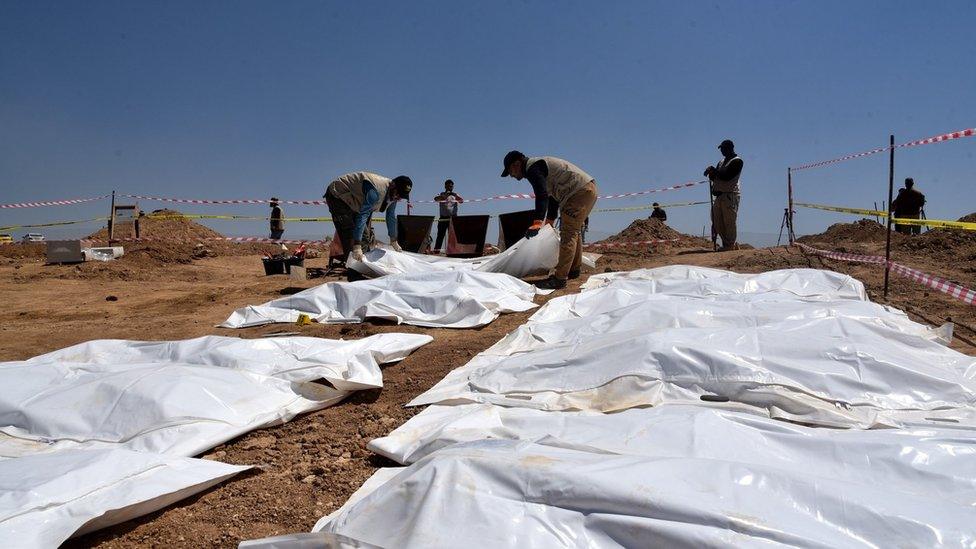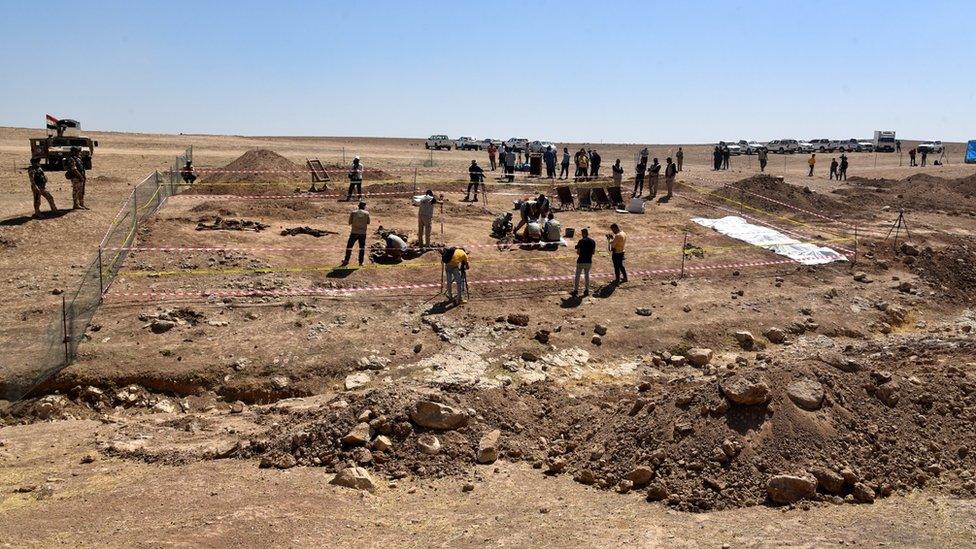IS Badoush prison massacre: Iraq exhumes bodies from mass grave
- Published

More than 600, mostly Shia Muslim, inmates at Badoush prison were summarily killed by IS militants
The remains of 123 victims of one of the worst massacres in Iraq by the jihadist group Islamic State have been exhumed from a mass grave near Mosul.
DNA samples will be compared with those collected from possible relatives in an attempt to identify them.
The victims were among more than 600 mostly Shia Muslim inmates at Badoush prison who were killed by IS in 2014.
IS militants drove them to a ravine and shot them dead after attacking the prison and freeing their fellow Sunnis.
The group once controlled 88,000 sq km (34,000 sq miles) of land stretching from eastern Iraq to western Syria and imposed its brutal rule on almost eight million people.
The liberation of that territory exposed the magnitude of the abuses inflicted by the group, including summary killings, torture, amputations, ethno-sectarian attacks, and the rape and sexual slavery of women and girls.
More than 200 mass graves containing the remains of up to 12,000 people have so far been discovered in Iraq, according to the United Nations, which has concluded that IS committed acts that may amount to war crimes, crimes against humanity and genocide.

Thousands of Iraqi families are waiting to know what happened to their relatives
"After 17 years of not knowing whether my son is alive or dead, I need an answer," Abbas Mohammed, whose son was jailed at Badoush in 2005, told AFP news agency.
The head of the mass grave section at Baghdad's forensic section, Dr Yasmin Munzer, said last week that 100 families had given blood samples in the capital, and that dozens of others had done so in four southern provinces. However, she noted that five other provinces still need to take samples before the identification process could begin.
According to the Office of the UN High Commissioner for Human Rights, external, IS militants took over Badoush prison on the morning of 10 June 2014 - the day they overran Mosul and sent shockwaves around the world.
The more than 3,000 inmates at the prison were separated into groups according to their ethnic or religious affiliation.
A project has hired locals of all faiths to work together to rebuild the city of Mosul (February 2021 report)
Sunnis were freed, while more than 600 others, mainly Shia, were loaded on trucks, driven to a ravine in an isolated stretch of desert about 2km (1.2 miles) away, and shot one by one by militants.
"They started by saying, 'Each person raise his hand and say his number.' I was number 43. I heard them say '615,' and then one IS guy said, 'We're going to eat well tonight,'" one survivor told the campaign group Human Rights Watch, external.
"A man behind us asked, 'Are you ready?' Another person answered 'Yes,' and began shooting at us with a machine-gun. Then they all started to shoot us from behind, going down the row," he added.
Some survivors told UN investigators that they immediately rolled into the ravine and were saved by other bodies landing on top of them.
IS militants kept shooting into the ravine at any moving body, including men who were screaming in pain.